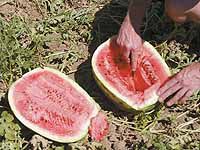Multi-generation businesses are not uncommon in Utah but if there is one family and one business that is unique to the community of Green River it is the Vetere Family and the melon business. John and Mary Vetere came over from Italy and started their melon business in Green River. And now, decades later, their son Jay still works the business, along with three of his four children. One son, Greg, has three young daughters help him with almost every aspect of the family business.
This is melon season in Green River and the Veteres not only have three stands in Green River, along I-70, but they provide a variety of watermelons and cantaloupes as far north as Orem and Provo.
This has been a challenging year for the melon growers and the Vetere family is no exception as one thing after another has caused chaos for the growers. A late cold snap delayed the planting process and then, one entire field was almost wiped out with strong winds that blew off the hot caps. It’s a long road from a small seed planted to a large, juicy and delicious Green River melon. Jay said, “We plant near the end of April. Some of the fields are planted with seeds, mostly the fields up the river. We plant small plants which were started in the hot houses. Then they are placed under hot caps. We had a hot wind that came along and a lot of our plants were burned and lost their leaves. They have come out of it pretty good but it placed us approximately two weeks behind. We’ve also had more weeds than usual. We cultivate around the plants to take care of the weeds and we don’t use any pesticides on the plants.
“We also surround the plant with black plastic which helps to keep the weeds down and keeps the plant warmer. We judge when the plants need water if they are a little wilted and if it is dry when you dig down in the dirt a few inches. We have water shares in the Green River canal. There is a diversion dam which diverts the water into and down the canal. We will water the melons on average six or seven times a year. It’s best to give the melons a quick drink and not soak them too much or the fruit won’t hold up.
| John and Mary Vetere came to Green River from Italy to start in the melon business. Now their son Jay (above) runs the business with three of his four children. |
“We thin the plants when they grow their third or fourth leaf. The rows are about 36 inches apart and the plants are about 20 inches apart. We have a machine that plants the seeds. We plant 45-50 acres in town and my son, Tim plants a bunch more up on the hill about eight miles out of town,” said Jay.
The unusual drought has delayed the growing season and now, over two weeks behind schedule the Veteres are forced to deal with the animals. On the upper place there are 65 head of antelope that have been eating on the melons and ruining the drip system that waters the plants. And down below, along the river, the bears, raccoons and even deer all take their toll. Greg, as he was delivering a fresh load of melons to one of the stands said that a single deer can eat as many as 15 or 20 cantaloupe in one evening. The Vetere family grows a wide variety of melons on about 100 acres, most of which lies along the banks of the Green River in southeast Emery County. “We also planted some late watermelons, so we’ll have fresh melons into November,” said Vetere.
Brand names like Crenshaw, Honeydew, Casaba, Isreali, Winter Queen, and Striped Clondike all make up the melon crop for the Veteres. These include those with and without seeds. Even these have changed over the years. The oldest, original melon is the Winter Queen, used to be a popular choice back east when they shipped the melons by train to New York and other parts of the east coast. But the seeds are impossible to get any longer and the family retains seeds from their original breed to continue this melon line.
Jay talked about the shipping process and the railroad as being a great way to carry the melons until a strike, back when he was young, stopped that marketing option. Apparently during one railroad strike all the melons sat on the tracks and spoiled. For many years now, the melons have been sold almost exclusively locally.
Greg, one of Jay’s sons who has also worked in the melon business all his life works side by side with his three daughters, Jill, Heidi, and Caitlyn. He explained that the girls help him with the early seedlings in the greenhouses or “hot houses,” then they work side by side as the baby plants are set out in the fields in May. When harvest season comes the girls work along with their dad loading the melons, sorting them and delivering them to the stands many times a day. “It’s too bad the girls have to go back to school so soon,” said Greg, “because I really could use their help the next few weeks. I am really going to miss them.”

